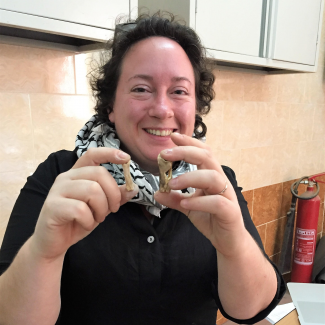Affiliation:

Dr. Kathryn Grossman is an Assistant Professor of Anthropology, North Carolina State University, and the director of the Makounta-Voules Archaeological Project. She is an archaeologist and zooarchaeologist, and her primary regions of focus are Southwest Asia and the eastern Mediterranean. Her current research focuses on resistance to state-making, the biographies of early cities, and human/non-human animal relationships in early complex societies. She is one of the Kershaw lecturers for the AIA’s 2023-2024 National Lecture Program.
In recent years, archaeologists have shifted their attention away from animals as passive participants in their own fate, and focused instead on animals as constitutive members of multispecies societies. The intertwined lives of humans, animals, things, and divinities come together dramatically in the case of religious sacrifice, where boundaries between worlds are broken down and rebuilt through ritual, death, and consumption. In a new project undertaken in collaboration with Erin Averett (Creighton Univ.) and David Reese (Yale), we consider the fates of people and animals as together they practice religious sacrifice in Cyprus in the Late Bronze and Iron Age. Cypriot religious and ritual iconography is rife with animal imagery, in votive offerings, depictions of deities, and zoomorphic masks, suggesting a broad role for animals in Cypriot religious life. This project considers animal remains from sanctuaries across Cyprus, along with art historical and archaeological evidence, and highlights the ways in which animals contributed to world-building (through the negotiation of earthly, liminal, and divine realms) and knowledge-creation (through prognostication and divination).
Against the backdrop of mainland southwest Asia, the island of Cyprus stands out as an anomaly during the third millennium BC. While their neighbors in Egypt, Mesopotamia, the Levant, and Anatolia were embarking on ambitious programs of urbanization and state formation, the inhabitants of Cyprus appear to have maintained a village-based society with few signs of institutionalized authority, social stratification, or hierarchically organized settlement systems and only occasional indications of aggrandizing behavior by individuals or households. On this evidence, Cyprus could be taken as a case of stunted development, but an alternative possibility has long been recognized: the villagers of Chalcolithic Cyprus may have been explicitly working to suppress movements toward the accumulation of wealth, power, and authority. The Makounta-Voules Archaeological Project is exploring this distinctive developmental trajectory through a consideration of the politics of village life in prehistoric Cyprus. An intensive survey (2017) and four seasons of excavation (2018–19, 2022-23) at the site of Makounta-Voules-Mersinoudia have documented the remains of a Chalcolithic and Early Bronze Age village on the northwest coast of the island near the modern town of Polis. My team at Makounta are exploring the evidence for household economy, community organization, craft production, and regimes of value in order to highlight the viability and the durability of alternative political projects that do not fit easily within the standard narrative of state formation in the region. In this talk, I’ll present new results from Makounta-Voules-Mersinoudia and discuss the site within the broader context of Chalcolithic Cyprus.
The ancient city of Petra, in Jordan, is best known for its monumental tombs and religious constructions. Recent excavations, however, are giving us a glimpse into a whole new facet of life at Petra – the complex relationships between humans and animals. In this talk, I discuss human-animal relationships as seen through the animal bones recovered from two areas of excavations at Petra. The first, on Petra’s North Ridge, revealed a complex of Roman-era houses. The second, at the Temple of the Winged Lions, revealed a Nabataean temple complex. In this talk, and drawing on these two data sets, I present a rather traditional look at the animal economy at Petra, and then delve deeper to consider the complexities of a multispecies community in this arid environment. I want to consider not just how humans used animals as economic resources, but also how the lives of humans and animals were intertwined in meaningful ways.